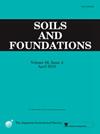Embankment vibration characteristics using ground motion records and ambient noise measurements, Briones Dam, California
IF 3.3
2区 工程技术
Q2 ENGINEERING, GEOLOGICAL
引用次数: 0
Abstract
Investigating the seismic response of earth embankment dams is crucial for assessing the safety of existing dams and guiding new design procedures. The dam fundamental frequency (f0) is a critical parameter in the dynamic response of dams and can be evaluated using seismic recordings through Horizontal-to-Vertical Spectral Ratio (HVSR) and Standard Spectral Ratio (SSR) methods. This study focuses on assessing the vibration characteristics of Briones Dam, a 78 m-tall earth embankment dam located in the Bay Area in Northern California. First, earthquake-based Horizontal-to-Vertical Spectral Ratio (eHVSR) was estimated by dividing the horizontal records by the vertical components, and the SSR was determined by comparing crest recordings with those from the abutment. Additionally, a field test program was conducted to collect ambient noise measurements at Briones Dam, allowing for the calculation of microtremor-based HVSR. The fundamental frequency was estimated using three empirical methods: mHVSR (0.7–1 Hz), eHVSR (0.9–1.1 Hz), and SSR (1.2 Hz). The median fundamental frequency of the dam is estimated to be approximately 1 Hz at the center of the dam crest. The slight variations among these three methods suggest the need for further investigations that consider the geological and geotechnical conditions of the dam.
使用地面运动记录和环境噪声测量的路堤振动特性,Briones大坝,加利福尼亚
研究土堤坝的地震反应对于评估现有坝的安全性和指导新的设计程序至关重要。大坝基频是大坝动力响应的关键参数,可以通过水平-垂直谱比(HVSR)和标准谱比(SSR)方法利用地震记录进行评价。本研究的重点是评估Briones大坝的振动特性,Briones大坝是位于北加州海湾地区的一座78米高的土堤防大坝。首先,将水平分量除以垂直分量,估算出基于地震的水平-垂直谱比(eHVSR),并将波峰记录与桥台记录进行比较,确定SSR。此外,还进行了现场测试程序,以收集Briones大坝的环境噪声测量数据,从而计算基于微震动的HVSR。采用mHVSR (0.7 ~ 1 Hz)、eHVSR (0.9 ~ 1.1 Hz)和SSR (1.2 Hz) 3种经验方法估算基频。大坝的基频中位数估计在坝顶中心约为1hz。这三种方法之间的细微差异表明需要进一步调查,考虑大坝的地质和岩土工程条件。
本文章由计算机程序翻译,如有差异,请以英文原文为准。
求助全文
约1分钟内获得全文
求助全文
来源期刊

Soils and Foundations
工程技术-地球科学综合
CiteScore
6.40
自引率
8.10%
发文量
99
审稿时长
5 months
期刊介绍:
Soils and Foundations is one of the leading journals in the field of soil mechanics and geotechnical engineering. It is the official journal of the Japanese Geotechnical Society (JGS)., The journal publishes a variety of original research paper, technical reports, technical notes, as well as the state-of-the-art reports upon invitation by the Editor, in the fields of soil and rock mechanics, geotechnical engineering, and environmental geotechnics. Since the publication of Volume 1, No.1 issue in June 1960, Soils and Foundations will celebrate the 60th anniversary in the year of 2020.
Soils and Foundations welcomes theoretical as well as practical work associated with the aforementioned field(s). Case studies that describe the original and interdisciplinary work applicable to geotechnical engineering are particularly encouraged. Discussions to each of the published articles are also welcomed in order to provide an avenue in which opinions of peers may be fed back or exchanged. In providing latest expertise on a specific topic, one issue out of six per year on average was allocated to include selected papers from the International Symposia which were held in Japan as well as overseas.
 求助内容:
求助内容: 应助结果提醒方式:
应助结果提醒方式:


